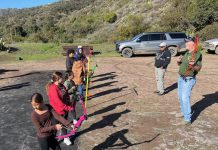Recently declassified documents, photographs and rare film footage reveal the Island’s top secret wartime history and its contributions to modern scuba diving in the “First Line of Defense: Catalina Island and World War II” exhibition currently on display at the Catalina Island Museum.
Starting in the summer of 1942, the United States Coast Guard and United States Maritime Service called Catalina Island home.
Recently declassified documents, photographs and rare film footage reveal the Island’s top secret wartime history and its contributions to modern scuba diving in the “First Line of Defense: Catalina Island and World War II” exhibition currently on display at the Catalina Island Museum.
Starting in the summer of 1942, the United States Coast Guard and United States Maritime Service called Catalina Island home.
The military installed a top secret radar station, anti-aircraft gun platforms and lookout towers on the windward side of the “magic isle” while servicemen endured intense training in Avalon and at the Isthmus.
As the nation’s involvement in the war grew, President Roosevelt established the Office of Strategic Services.
Naming William “Wild Bill” Donovan as director of this top secret organization, the United States entered into the world of spies, espionage and guerilla warfare—a tactic never-before used by the United States government.
Locations on Catalina Island such as Toyon Bay, Howland’s Landing and Fourth of July Cove offered the OSS extremely isolated facilities as well as coastal regions that were thought to resemble South Pacific Islands.
Between 1943 and 1945 the Island was used by the OSS for covert training and top secret operations.
In response to the ever-changing face of war in the Pacific, the Special Operations branch of the OSS created the Maritime Unit.
Director Donovan chose Catalina Island, known for its crystal clear waters, as a strategic location for the training of his elite group of amphibious soldiers.
The Maritime Unit recruited Dr. Christian Lambertsen to perfect his revolutionary re-breathing device—the “Lambertsen Amphibious Respirator Unit” or “Lambertsen Lung”—and train combat swimmers in its use.
The Maritime Unit trained in small craft handling, underwater explosive devices and specialized boats such as collapsible kayaks and inflatable surfboards that could be launched from submarines.
The “Lambertsen Lung” allowed them to conduct long-range operations underwater without creating bubbles on the surface.
The Maritime Unit also developed flexible swim fins used by the combat swimmers or “Frogmen.”
The origins of modern scuba diving and the way that mankind would come to experience the underwater world started with the OSS on Catalina Island.
The OSS Maritime Unit became America’s first group of combat swimmers and the origins of many of the tactics of the later Underwater Demolition Teams and Navy SEALS can be directly traced back to this group.
“First Line of Defense: Catalina Island and World War II” is on exhibit through April 28, 2013 at the Catalina Island Museum.
The Catalina Island Museum is Avalon’s sole institution devoted to art, culture and history.
The museum, its digital theater and store are located on the ground floor of Avalon’s historic Casino and are open seven days a week, from 10 a.m. to 5 p.m.
For more information, call the museum at (310) 510-2414 or visit CatalinaMuseum.org.










